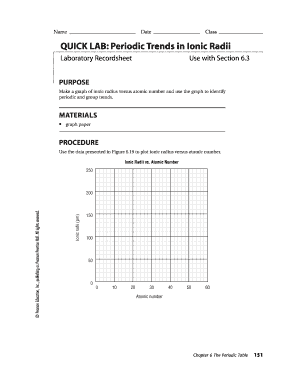Loading

Get Quick Lab Periodic Trends In Ionic Radii
How it works
-
Open form follow the instructions
-
Easily sign the form with your finger
-
Send filled & signed form or save
How to fill out the Quick Lab periodic trends in ionic radii online
This guide provides users with clear steps to effectively fill out the Quick Lab periodic trends in ionic radii form online. By following these instructions, users will be able to complete their laboratory record sheet with confidence.
Follow the steps to successfully complete the form.
- Press the ‘Get Form’ button to retrieve the form and open it in the online editor.
- Enter your name in the designated field at the top of the form to identify yourself.
- Fill in the date of completion in the appropriate date field to document when the lab is performed.
- Input your class information in the class field, allowing for organized record-keeping.
- Refer to Figure 6.19 to plot ionic radius versus atomic number on the provided graph paper. Ensure to label your axes clearly, with ionic radius on the y-axis and atomic number on the x-axis.
- Complete the analyses and conclusions section by addressing each question thoroughly and providing clear explanations.
- Once all fields are filled and the graph is complete, save your changes, and choose to download, print, or share your completed form as needed.
Start filling out the Quick Lab periodic trends in ionic radii online today!
The size of an element's ionic radius follows a predictable trend on the periodic table. As you move down a column or group, the ionic radius increases. This is because each row adds a new electron shell. Ionic radius decreases moving from left to right across a row or period.
Industry-leading security and compliance
US Legal Forms protects your data by complying with industry-specific security standards.
-
In businnes since 199725+ years providing professional legal documents.
-
Accredited businessGuarantees that a business meets BBB accreditation standards in the US and Canada.
-
Secured by BraintreeValidated Level 1 PCI DSS compliant payment gateway that accepts most major credit and debit card brands from across the globe.


